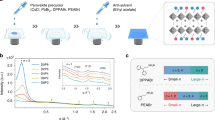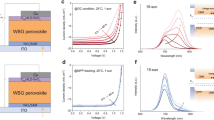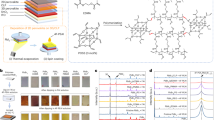Abstract
Perovskite solar cells with submicrometre-thick CH3NH3PbI3 or CH3NH3PbI3–xClx active layers show a power conversion efficiency as high as 15%. However, compared to the best-performing device, the average efficiency was as low as 12%, with a large standard deviation (s.d.). Here, we report perovskite solar cells with an average efficiency exceeding 16% and best efficiency of 17%. This was enabled by the growth of CH3NH3PbI3 cuboids with a controlled size via a two-step spin-coating procedure. Spin-coating of a solution of CH3NH3I with different concentrations follows the spin-coating of PbI2, and the cuboid size of CH3NH3PbI3 is found to strongly depend on the concentration of CH3NH3I. Light-harvesting efficiency and charge-carrier extraction are significantly affected by the cuboid size. Under simulated one-sun illumination, average efficiencies of 16.4% (s.d. ± 0.35), 16.3% (s.d. ± 0.44) and 13.5% (s.d. ± 0.34) are obtained from solutions of CH3NH3I with concentrations of 0.038 M, 0.050 M and 0.063 M, respectively. By controlling the size of the cuboids of CH3NH3PbI3 during their growth, we achieved the best efficiency of 17.01% with a photocurrent density of 21.64 mA cm–2, open-circuit photovoltage of 1.056 V and fill factor of 0.741.
This is a preview of subscription content, access via your institution
Access options
Subscribe to this journal
Receive 12 print issues and online access
$259.00 per year
only $21.58 per issue
Buy this article
- Purchase on Springer Link
- Instant access to full article PDF
Prices may be subject to local taxes which are calculated during checkout





Similar content being viewed by others
References
Kojima, A., Teshima, K., Shirai, Y. & Miyasaka, T. Organometal halide perovskites as visible-light sensitizers for photovoltaic cells. J. Am. Chem. Soc. 131, 6050–6051 (2009).
Im, J-H., Lee, C-R., Lee, J-W., Park, S-W. & Park, N-G. 6.5% efficient perovskite quantum-dot-sensitized solar cell. Nanoscale 3, 4088–4093 (2011).
Kim, H-S. et al. Lead iodide perovskite sensitized all-solid-state submicron thin film mesoscopic solar cell with efficiency exceeding 9%. Sci. Rep. 2, 591 (2012).
Burschka, J. et al. Sequential deposition as a route to high-performance perovskite-sensitized solar cells. Nature 499, 316–319 (2013).
Liu, M., Johnston, M. B. & Snaith, H. J. Efficient planar heterojunction perovskite solar cells by vapour deposition. Nature 501, 395–398 (2013).
Wojciechowski, K., Saliba, M., Leijtens, T., Abate, A. & Snaith, H. J. Sub-150 °C processed meso-superstructured perovskite solar cells with enhanced efficiency. Energy Environ. Sci. 7, 1142–1147 (2014).
Wang, J. T-W. et al. Low-temperature processed electron collection layers of graphene/TiO2 nanocomposites in thin film perovskite solar cells. Nano Lett. 14, 724–730 (2014).
Lee, M. M., Teuscher, J., Miyasaka, T., Murakami, T. N. & Snaith, H. J. Efficient hybrid solar cells based on meso-superstructured organometal halide perovskites. Science 338, 643–647 (2012).
Heo, J. H. et al. Efficient inorganic–organic hybrid heterojunction solar cells containing perovskite compound and polymeric hole conductors. Nature Photon. 7, 486–491 (2013).
Xing, G. et al. Long-range balanced electron- and hole-transport length in organic–inorganic CH3NH3PbI3 . Science 342, 344–347 (2013).
Stranks, S. D. et al. Electron–hole diffusion lengths exceeding 1 micrometer in an organometal trihalide perovskite absorber. Science 342, 341–344 (2013).
Gonzalez-Pedro, V. et al. General working principles of CH3NH3PbX3 perovskite solar cells. Nano Lett. 14, 888–893 (2014).
Liang, K., Mitzi, D. B. & Prikas, M. T. Synthesis and characterization of organic–inorganic perovskite thin films prepared using a versatile two-step dipping technique. Chem. Mater. 10, 403–411 (1998).
Juška, G., Arlauskas, K., Viliūnas, M. & Kočka, J. Extraction current transients: new method of study of charge transport in microcrystalline silicon. Phys. Rev. Lett. 84, 4946–4949 (2000).
Fraas, L. M. Basic grain-boundary effects in polycrystalline heterostructure solar cells. J. Appl. Phys. 49, 871–875 (1978).
Snaith, H. J. et al. Anomalous hysteresis in perovskite solar cells. J. Phys. Chem. Lett. 5, 1511–1515 (2014).
Sanchez, R. S. et al. Slow dynamic process in lead halide perovskite solar cells. Characteristic times and hysteresis. J. Phys. Chem. Lett. 5, 2357–2363 (2014).
Jeon, N. J. et al. Solvent engineering for high-performance inorganic–organic hybrid perovskite solar cells. Nature Mater. 13, 897–903 (2014).
Acknowledgements
This work was supported by National Research Foundation of Korea (NRF) grants, funded by the Ministry of Science, ICT & Future Planning (MSIP) of Korea under contracts nos. NRF-2010-0014992, NRF-2012M1A2A2671721, NRF-2012M3A7B4049986 (Nano Material Technology Development Program) and NRF-2012M3A6A7054861 (Global Frontier R&D Program on Center for Multiscale Energy System). M.G. acknowledges an Advanced Research Grant (ARG 247404) from the European Research Council (ERC), funded under the ‘Mesolight’ project.
Author information
Authors and Affiliations
Contributions
N.G.P. conceived the experiments, performed data analysis and prepared the manuscript. J.H.I. and I.H.J. prepared materials, fabricated devices and characterized device structure and performance. M.G. analysed optical and IPCE data and edited the manuscript. N.P. measured light-harvesting efficiency and photo-CELIV. All authors discussed the results and commented on the manuscript.
Corresponding authors
Ethics declarations
Competing interests
The authors declare no competing financial interests.
Supplementary information
Supplementary information
Supplementary Information (PDF 858 kb)
Rights and permissions
About this article
Cite this article
Im, JH., Jang, IH., Pellet, N. et al. Growth of CH3NH3PbI3 cuboids with controlled size for high-efficiency perovskite solar cells. Nature Nanotech 9, 927–932 (2014). https://doi.org/10.1038/nnano.2014.181
Received:
Accepted:
Published:
Issue Date:
DOI: https://doi.org/10.1038/nnano.2014.181
This article is cited by
-
Order-disorder phase transition driven by interlayer sliding in lead iodides
Nature Communications (2023)
-
Boosting efficiency and stability of perovskite solar cells via integrating engineered Li/Na-ferrite-based inorganic charge transport layers: a combined experimental and theoretical study
Journal of Nanoparticle Research (2023)
-
Microwave hydrothermal preparation of reduced graphene oxide-induced p-AgO/n-MoO3 heterostructures for enhanced photocatalytic activity through S-scheme mechanism and its electronic performance
Environmental Science and Pollution Research (2023)
-
A Review on Interface Engineering of MXenes for Perovskite Solar Cells
Nano-Micro Letters (2023)
-
A high‐efficiency and stable perovskite solar cell fabricated in ambient air using a polyaniline passivation layer
Scientific Reports (2022)



